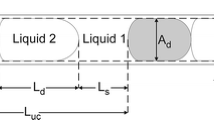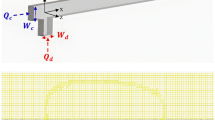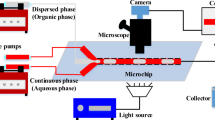Abstract
Flow regimes of two immiscible liquids at the cross junction within a rectangular microchannel are experimentally investigated. Characteristics of the flow regimes including critical conditions and interfacial deformations are presented. It is found that the occurrence of the tubing regime is favored by increased viscosity of the dispersed phase or reduced cross-sectional aspect ratio, leading to the shrinkage of the flow rate range that could produce droplets. In order to reveal the physical mechanism, the force analysis is carried out based on the tunnel structure formed between the interface and channel side walls within the rectangular cross-section. The reshaping stage and pinch-off stage are mainly driven by the interfacial tension, leading to far larger neck thinning rate compared to the superficial velocity of either phase. The filling stage and squeezing stage are dominated by the pressure drop across the dispersed tip while the role of the shear force becomes more important with increasing tunnel width. The filling period is estimated as t2≈kHwn02/Qd with k = 1.34 and the squeezing period is expressed as t3/Tc = 0.3Cac−1. According to the force analysis, the critical tip velocity under dripping scales with three key parameters, which can be expressed as (utip/U)* ~ QcLtip/wtunnel3.
Graphic abstract
Flow regimes of two immiscible liquids at the cross junction within a rectangular microchannel are experimentally investigated. Distribution maps and critical conditions of four flow regimes are presented. Interfacial deformations during the droplet generation at regimes of squeezing and dripping are compared. Force analysis is carried out based on the different tunnel shape confined by the rectangular cross-section.











Similar content being viewed by others
Abbreviations
- F P :
-
Force caused by pressure drop (N)
- F τ :
-
Force caused by shear stress (N)
- H :
-
Height of microchannels (m)
- L tip :
-
Length of dispersed tip (m)
- Q d :
-
Volumetric flow rate of dispersed phase (m3/s)
- Q c :
-
Volumetric flow rate of continuous phase (m3/s)
- Q :
-
Flow rate ratio of two liquid phases (q = Qd/Qc)
- q* :
-
Critical flow rate ratio of tubing
- R 1 :
-
Radii of in-plane curvature (m)
- R 2 :
-
Radii of out-of-plane curvature (m)
- T :
-
Time (s)
- t 2 :
-
Period of stage II (filling stage) (s)
- t 3 :
-
Period of stage III (squeezing stage) (s)
- t 4 :
-
Period of stage IV (pinch-off stage) (s)
- T c :
-
Capillary time (Tc = (ρcW3/σ)1/2) (s)
- U :
-
Superficial velocity of mixed liquids in focusing channel (m/s)
- U c :
-
Superficial velocity of continuous phase (m/s)
- U d :
-
Superficial velocity of dispersed phase (m/s)
- u n :
-
Thinning rate of neck (m/s)
- u tip :
-
Dispersed tip velocity (m/s)
- V tip :
-
Volume of the dispersed tip at the end of filling stage (m3)
- W c :
-
Width of inlet channel of continuous phase (m)
- W d :
-
Width of inlet channel of dispersed phase (m)
- W :
-
Width of focusing channel (m)
- w n :
-
Neck width (m)
- w n 0 :
-
Initial neck width at the beginning of squeezing stage (m)
- w tunnel :
-
Width of tunnel between droplet interface and side walls (m)
- x tip :
-
Dispersed tip position along the x axis (m)
- μ :
-
Viscosity (Pa·s)
- ρ :
-
Density (kg/m3)
- σ :
-
Interfacial tension coefficient (N/m)
- δ :
-
Width ratio of inlet channels (δ = Wd/Wc)
- ω :
-
Aspect ratio of the cross-section of focusing channel (ω = H/W)
- λ :
-
Viscosity ratio of two liquid phases (λ = μd/μc)
- ΔP :
-
Pressure drop across dispersed tip (Pa)
- ΔP L :
-
Laplace pressure jump (Pa)
- τ c :
-
Shear stress exerted by continuous tip (Pa)
- τ d :
-
Viscous stress of dispersed phase (Pa)
- Ca :
-
Capillary number (Ca = μU/σ)
- We :
-
Weber number (We = ρU2W/σ)
- d :
-
Dispersed phase
- c :
-
Continuous phase
- n :
-
Neck
References
Dressler, O.J., Casadevall, I.S.X., deMello, A.J.: Chemical and biological dynamics using droplet-based microfluidics. Annu. Rev. Anal. Chem. 10(1), 1–24 (2017)
Anna, S.L.: Droplets and bubbles in microfluidic devices. Annu. Rev. Fluid Mech. 48(1), 285–309 (2016)
Pang, Y., Kim, H., Liu, Z., et al.: A soft microchannel decreases polydispersity of droplet generation. Lab Chip. 14(20), 4029–4034 (2014)
Shang, L., Cheng, Y., Zhao, Y.: Emerging Droplet Microfluidics. Chem Rev. 117(12), 7964–8040 (2017)
Si, T., Li, G., Wu, Q., et al.: Optical droplet vaporization of nanoparticle-loaded stimuli-responsive microbubbles. Appl. Phys. Lett. 108(11), 111109 (2016)
Wang, X., Liu, Z., Pang, Y.: Concentration gradient generation methods based on microfluidic systems. RSC Adv. 7(48), 29966–29984 (2017)
Wang, X., Liu, Z., Pang, Y.: Droplet breakup in an asymmetric bifurcation with two angled branches. Chem. Eng. Sci. 188, 11–17 (2018)
Liu, C., Hu, G., Jiang, X., et al.: Inertial focusing of spherical particles in rectangular microchannels over a wide range of Reynolds numbers. Lab Chip 15(4), 1168–1177 (2015)
Baroud, C.N., Gallaire, F., Dangla, R.: Dynamics of microfluidic droplets. Lab Chip 10(16), 2032–2045 (2010)
Zhu, P., Wang, L.: Passive and active droplet generation with microfluidics: a review. Lab Chip. 17(1), 34–75 (2016)
Um, E., Kim, M., Kim, H., et al.: Phase synchronization of fluid-fluid interfaces as hydrodynamically coupled oscillators. Nat. Commun. 11(1), 5221 (2020)
Wang, N., Semprebon, C., Liu, H., et al.: Modelling double emulsion formation in planar flow-focusing microchannels. J. Fluid Mech. 895, 1 (2020)
Salkin, L., Schmit, A., Courbin, L., et al.: Passive breakups of isolated drops and one-dimensional assemblies of drops in microfluidic geometries: experiments and models. Lab Chip. 13(15), 3022–3032 (2013)
Wang, X., Liu, Z., Pang, Y.: Breakup dynamics of droplets in an asymmetric bifurcation by μPIV and theoretical investigations. Chem. Eng. Sci. 197, 258–268 (2019)
Zhang, S., Guivier-Curien, C., Veesler, S., et al.: Prediction of sizes and frequencies of nanoliter-sized droplets in cylindrical T-junction microfluidics. Chem. Eng. Sci. 138, 128–139 (2015)
Pang, Y., Zhou, Q., Wang, X., et al.: Droplets generation under different flow rates in T-junction microchannel with a neck. AIChE J. 66(10), e16290 (2020)
Chen, X., Xue, C., Hu, G.: Confinements regulate capillary instabilities of fluid threads. J. Fluid Mech. 873, 816–834 (2019)
Yao, C., Liu, Y., Xu, C., et al.: Formation of liquid-liquid slug flow in a microfluidic T-junction: effects of fluid properties and leakage flow. AIChE J. 64(1), 346–357 (2018)
van Steijn, V., Kleijn, C.R., Kreutzer, M.T.: Flows around confined bubbles and their importance in triggering pinch-off. Phys Rev Lett. 103(21), 214501 (2009)
Gupta, A., Sbragaglia, M.: A lattice Boltzmann study of the effects of viscoelasticity on droplet formation in microfluidic cross-junctions. Eur. Phys. J. E 39(1), 1–15 (2016)
Ngo, I.L., Dang, T.D., Byon, C., et al.: A numerical study on the dynamics of droplet formation in a microfluidic double T-junction. Biomicrofluidics 9(2), 024107–024107 (2015)
Che, Z., Nguyen, N.T., Wong, T.N.: Hydrodynamically mediated breakup of droplets in microchannels. Appl. Phys. Lett. 98(5), 54102 (2011)
Rostami, B., Morini, G.L.: Experimental characterization of a micro cross-junction as generator of Newtonian and non-Newtonian droplets in silicone oil flow at low Capillary numbers. Exp. Thermal Fluid Sci. 103, 191–200 (2019)
van Loo, S., Stoukatch, S., Kraft, M., et al.: Droplet formation by squeezing in a microfluidic cross-junction. Microfluid. Nanofluid. 20(10), 146 (2016)
Li, X., He, L., He, Y., et al.: Numerical study of droplet formation in the ordinary and modified T-junctions. Phys. Fluids. 31(8), 82101 (2019)
Liu, H., Zhang, Y.: Droplet formation in a T-shaped microfluidic junction. J. Appl. Phys. 106(3), 34906 (2009)
Mastiani, M., Seo, S., Jimenez, S.M., et al.: Flow regime mapping of aqueous two-phase system droplets in flow-focusing geometries. Colloids Surf. A 531, 111–120 (2017)
Arias, S., Montlaur, A.: Numerical study and experimental comparison of two-phase flow generation in a T-junction. AIAA J. 55(5), 1565–1574 (2017)
Chen, X., Glawdel, T., Cui, N., et al.: Model of droplet generation in flow focusing generators operating in the squeezing regime. Microfluid. Nanofluid. 18(5–6), 1341–1353 (2014)
Tan, J., Xu, J.H., Li, S.W., et al.: Drop dispenser in a cross-junction microfluidic device: Scaling and mechanism of break-up. Chem. Eng. J. 136(2), 306–311 (2008)
Liu, H., Zhang, Y.: Lattice Boltzmann simulation of droplet generation in a microfluidic cross-junction. Commun. Comput. Phys. 9(5), 1235–1256 (2011)
Garstecki, P., Fuerstman, M.J., Stone, H.A., et al.: Formation of droplets and bubbles in a microfluidic T-junction-scaling and mechanism of break-up. Lab Chip. 6(3), 437–446 (2006)
Cubaud, T., Mason, T.G.: Capillary threads and viscous droplets in square microchannels. Phys. Fluids 20(5), 53302 (2008)
Liu, H., Zhang, Y.: Droplet formation in microfluidic cross-junctions. Phys. Fluids. 23(8), 82101 (2011)
Yu, W., Liu, X., Zhao, Y., et al.: Droplet generation hydrodynamics in the microfluidic cross-junction with different junction angles. Chem. Eng. Sci. 203, 259–284 (2019)
Christopher, G.F., Noharuddin, N.N., Taylor, J.A., et al.: Experimental observations of the squeezing-to-dripping transition in T-shaped microfluidic junctions. Phys. Rev. E. 78(3), 36317 (2008)
Du, W., Fu, T., Zhu, C., et al.: Breakup dynamics for high-viscosity droplet formation in a flow-focusing device: Symmetrical and asymmetrical ruptures. AIChE J. 62(1), 325–337 (2016)
Du, W., Fu, T., Duan, Y., et al.: Breakup dynamics for droplet formation in shear-thinning fluids in a flow-focusing device. Chem. Eng. Sci. 176, 66–76 (2018)
Wu, Z., Sundén, B.: Liquid-liquid two-phase flow patterns in ultra-shallow straight and serpentine microchannels. Heat Mass Transf. 55(4), 1095–1108 (2018)
Funfschilling, D., Debas, H., Li, H.Z., et al.: Flow-field dynamics during droplet formation by dripping in hydrodynamic-focusing microfluidics. Phys. Rev. E 80(1 Pt 2), 15301 (2009)
Wu, L., Tsutahara, M., Kim, L.S., et al.: Three-dimensional lattice Boltzmann simulations of droplet formation in a cross-junction microchannel. Int. J. Multiph. Flow 34(9), 852–864 (2008)
Fu, T., Wu, Y., Ma, Y., et al.: Droplet formation and breakup dynamics in microfluidic flow-focusing devices: from dripping to jetting. Chem. Eng. Sci. 84, 207–217 (2012)
Roumpea, E., Kovalchuk, N., Chinaud, M., et al.: Experimental studies on droplet formation in a flow-focusing microchannel in the presence of surfactants. Chem. Eng. Sci. 195, 507–518 (2019)
Mazutis, L., Griffiths, A.D.: Selective droplet coalescence using microfluidic systems. Lab Chip. 12(10), 1800–1806 (2012)
Peltonen, L., Hirvonen, J., Yliruusi, J.: The behavior of sorbitan surfactants at the water-oil interface: straight-chained hydrocarbons from pentane to dodecane as an oil phase. J Colloid Interface Sci. 240(1), 272–276 (2001)
Wu, Z., Cao, Z., Sunden, B.: Flow patterns and slug scaling of liquid-liquid flow in square microchannels. Int. J. Multiph. Flow 112, 27–39 (2019)
Chakraborty, I., Ricouvier, J., Yazhgur, P., et al.: Droplet generation at Hele-Shaw microfluidic T-junction. Phys. Fluids. 31(2), 22010 (2019)
Aytouna, M., Paredes, J., Shahidzadeh-Bonn, N., et al.: Drop formation in non-Newtonian fluids. Phys. Rev. Lett. 110(3), 34501 (2013)
De Menech, M., Garstecki, P., Jousse, F., et al.: Transition from squeezing to dripping in a microfluidic T-shaped junction. J. Fluid Mech. 595, 141–161 (2008)
Romero, P.A., Abate, A.R.: Flow focusing geometry generates droplets through a plug and squeeze mechanism. Lab Chip 12(24), 5130–5132 (2012)
Yang, H., Zhou, Q., Fan, L.S.: Three-dimensional numerical study on droplet formation and cell encapsulation process in a micro T-junction. Chem. Eng. Sci. 87, 100–110 (2013)
van Steijn, V., Kleijn, C.R., Kreutzer, M.T.: Predictive model for the size of bubbles and droplets created in microfluidic T-junctions. Lab Chip. 10(19), 2513–2518 (2010)
Fuerstman, M.J., Lai, A., Thurlow, M.E., et al.: The pressure drop along rectangular microchannels containing bubbles. Lab Chip. 7(11), 1479–1489 (2007)
Acknowledgements
This work was supported by the National Natural Science Foundation of China (Grants 11872083 and 11702007), the China Postdoctoral Science Foundation (Grant 2020M680270), the Beijing Postdoctoral Research Foundation (Grant 2020-ZZ-075), and the Chaoyang District Postdoctoral Research Foundation (Grant 2020ZZ-40).
Author information
Authors and Affiliations
Corresponding author
Additional information
Executive Editor: Mingjiu Ni
Supplementary Information
Below is the link to the electronic supplementary material.
Supplementary file1 (MP4 10792 KB)
Supplementary file2 (MP4 5175 KB)
Supplementary file3 (MP4 7316 KB)
Supplementary file5 (MP4 1603 KB)
Rights and permissions
About this article
Cite this article
Wang, X., Pang, Y., Ma, Y. et al. Flow regimes of the immiscible liquids within a rectangular microchannel. Acta Mech. Sin. 37, 1544–1556 (2021). https://doi.org/10.1007/s10409-021-01128-5
Received:
Accepted:
Published:
Issue Date:
DOI: https://doi.org/10.1007/s10409-021-01128-5




